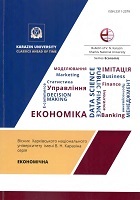Business relations under transformation influences
Abstract
The article aims to study and analyze the influence of transformation on business relations in East European countries. It includes revealing the essence of the transformation change, formal rules, informal constraints and enforcement characteristics. Literature review suggests that political and socioeconomic changes can affect transformation reforms in the framework of speeding them up. The process of convergence of the new institutional economy and the evolutionary economy theories demonstrate confirms the existence of common theoretical foundations. They include recognition of the existence of limits of rational behavior of economic entities, unpredictability, and irreversibility of business decision-making process. Institutional transformation assumes a complex process, where mechanical copying and transferring institutions do not provide quantitative changes, and need the development of formal rules and informal institutions, law enforcement mechanism, as well as consciousness and mental characteristics of the population. The content of the modern institutional system of transformation, including the institutional-legal, institutional-economic and institutional-technological systems, is presented. The systematization of classification features is carried out: content, the main tasks and results of the functioning of the institutional transformation subsystems. The effectiveness of the present system is considered, based on revealing the relationship and the influence of all its subsystems. Transformation changes affect business environment, and result in foundation of a stronger legal framework and a system of property rights, decreasing bureaucracy, and enhancing competition. The success of any efforts to weaken the influence of ineffective institutions will depend primarily on whether East European countries’ present-day facade institutions can be replaced with institutions that are robust and independent. Application of the interdisciplinary approach promotes an in-depth study the drivers of transformation reforms, and proposes scenarios for future development of East European countries.
Downloads
References
Kuzmina, Y. I., Bendukidze, K.Y., Yudkevich, M. M. (2006). The course of institutional economics. institutes, networks, transaction costs. contracts. Moscow: Publisher House of the Higher School of Economics. (in Russian)
Skorobogatov, A. (2006). Institutions as a factor of order and as a source of chaos. Questions of Economics, 8, 102-118. (in Russian)
Malevich, Y. (2002). Institutional equilibrium. Ecological Survey, 2, 276-300.
Glinkina, S. (2010). Post-communist transformations: multilevel analysis methodology. Ekonomski pregled, 61(11), 699-716.
North, D.C. (1989). Institutions and economic growth. An historical introduction. World Development, 17(9), 1319-1332.
Nabli, M.K., Nugent, J.B. (1989). The new institutional economics and its applicability to development. World Development, 17(9), 1333-1347.
Furceri, D. and Zdzienicka, A. (2011). How Costly are Debt Crises? IMF Working Papers, 11/280, 1-29. Retrieved from https://ssrn.com/abstract=1971431.
Schadler, S., Mody, S., Abiad, A., Leigh, D. (2006). Growth in the Central and Eastern European countries of the European Union. IMF Occasional papers, 252, Washington D.C.: International Monetary Fund. Retrieved from https://www.imf.org/en/Publications/Occasional-Papers/Issues/2016/12/31/Growth-in-the-Central-and-Eastern-European-Countries-of-the-European-Union-19210.
Eurostat. Retrieved from http://epp.eurostat.ec.europa.eu/portal/page/portal/eurostat/home/.
Kornai, J. (2006). Great Transformation of the Central – East Europe: success and disappointment. Economics of transition, 14(2), 207-244. doi: https://doi.org/10.1111/j.1468-0351.2006.00252.x.
Tridico, P. (2011). Institutions, Human Development and Economic Growth in Transition Economies. London: Palgrave Macmillan. doi: https://doi.org/10.1057/9780230313880.
Transition Report, 2001. London: EBRD. Retrieved from https://www.ebrd.com/publications/transition-report-2001-english.pdf.
Lissowska, M. (2008). Institutions for market economy. The case of Poland. Warszawa: Wydawnictwo C.H. Beck.
Romisch, R., Brown, A., Gardiner, B., Stenning, J. (2017). Economic challenges of lagging regions i: fiscal and macroeconomic environment. WIIW Research Report, 421. Retrieved from https://www.econstor.eu/handle/10419/204193.
Gaydaev, V., Ladygin, D. (2012). World leaders put on cadres. Kommersant. Retrieved from http://www.kommersant.ru/doc/1858101. (in Russian)
Rekine, A., Walsh, P.P. (1998). European trade and foreign direct investment. U-Shaping industrial output in Central and Eastern Europe: theory and evidence. IMF Working Paper, 98/150. Retrieved from https://econpapers.repec.org/paper/imfimfwpa/98_2f150.htm.
Hoekman, B., Djankov, S. (2001). Intra-industry trade, foreign direct investment, and the orientation of Eastern European exports. World Bank Policy Research Working Paper, 1652. doi: https://doi.org/10.1596/1813-9450-1652.
Dritsaki, M., Dritsaki, C., Adamapolous, A. (2004). A causal relationship between trade, foreign direct investment and economic growth for Greece. American Journal of Applied Sciences, 1(3), 230-235.
Djankov, S. (2016). Challenges to Eastern Europe’s growth. Background paper for the panel on reinvigorating growth, Competitiveness and investment, EBRD Conference, Budapest.
Stiglitz, J. E. (1999). Whither Reform. 10 years of transition. keynote address. Annual Bank Conference on Development Economics. Washington: D.C.
Akaev, A. A., Ichkitidze,Y. R., Sarygulov, A. I., Sokolov, V. N. (2016). Post-socialist transformation of Central and Eastern Europe at the Turn of the Century: Regional Development and Economic Inequality. R-Economy, 2(3), 279-289. doi: doi 10.15826/recon.2016.2.3.025.
Mitra, P., Yemtsov, R., (2006). Increasing inequality in transition economies: is there more to come? World Bank Policy Research Working Paper, 4007. Retrieved from http://documents.worldbank.org/curated/en/733471468282883074/Increasing-inequality-in-transition-economies-is-there-more-to-come.
Yasin, E., Snegovaya, M. (2010). Institutional problems of russia in the global context. Problems of Economics, 1, 123-139. (in Russian)
Nosova, O. (2017). The Impact of globalization on financial institutions’ development. Europa Regionum, XXX(1), 99–119.
Stehrer, R., Leitner, S. M. (2019). Demographic challenges for labour supply and growth. Research Report, 439. Retrieved from https://wiiw.ac.at/demographic-challenges-for-labour-supply-and-growth-dlp-4868.pdf.
North, D., Wallis, J., Webb, S., Weingast, B. (Eds.). (2012). In the shadow of violence: politics, economics and the problems of development. Cambridge: Cambridge University Press. doi: https://doi.org/10.1017/CBO9781139013611.

